Page 3 sur 6
Re: Ghibli de Hongrie [ENG]
Publié : mer. 27 juin 2018 12:06
par Froggie
Did you have a corresponding gasket deterioration and possible water pathway in the shown circled zones where the head was pitted?
The imperfections of the casting may also be responsible for preferred water pathways and localised corrosion.
As alpa says, sanding the surface a few ten thous may do it and close the paths
Re: Ghibli de Hongrie [ENG]
Publié : mer. 27 juin 2018 22:43
par spacecadet
alpa a écrit :I did not get answer from Regina, not surprising, Maseralfa explained in Italy you have to call before writting to them

.
He'll try as a professional, he owns a parts business.
Oh, great. I've heard the same, and of course you have to speak Italian

alpa a écrit :
Your head looks like having had strong ping, ping melts down the surface. But it usually happens on pistons, not on the head. At least I have not seen such case but I don't have so much experience with this. Check piston crown when it's in TDC. These heads are extremely well designed so they are very well cooled. And pistons are forged. So it may be OK after some cleaning and surfacing.
I've checked the piston, haven't noticed anything, but it's covered in crud, might be that it has a small missing piece? Will try to clean it and check again.
alpa a écrit :
Valves are OK and yes they are close to the surface but this is how F1 heads are

. It's written Coscast, not a mistake, it's Cosworth.
Head oxydation is not unusual on old engines. You'll see more once surfaced, removing 0.1mm may suffice.
Does this oxidation that mean that gaskets are not designed for such a long time? Or improper coolant? Or if the car is running rare the corrosion inhibitors are not flowed properly through the engine? I'm just guessing here.
Valves seemed to me so close the the surface that removing any material will cause cutting into the seat, but I've never seen similar heads. Neither F1 heads

alpa a écrit :
Note that valve seats are very special (round shaped like on F1 engines, not angled) so don't allow any wanker to work on them. There is only one angle on them.
So it's not simply the traditional 45 degrees cut as the manual writes for recentering the seats when changing guides?
Froggie a écrit :Did you have a corresponding gasket deterioration and possible water pathway in the shown circled zones where the head was pitted?
The imperfections of the casting may also be responsible for preferred water pathways and localised corrosion.
As alpa says, sanding the surface a few ten thous may do it and close the paths
Yes, the pittings are at the worst gasket deterioration areas where the coolant seeped through (slightly visible on the first picture).
Re: Ghibli de Hongrie [ENG]
Publié : jeu. 28 juin 2018 20:41
par spacecadet
With some help I've removed the valves. There is definitely carbon buildup on the exhaust seats contributing to the leak, which was also verified before disassembly using liquid.
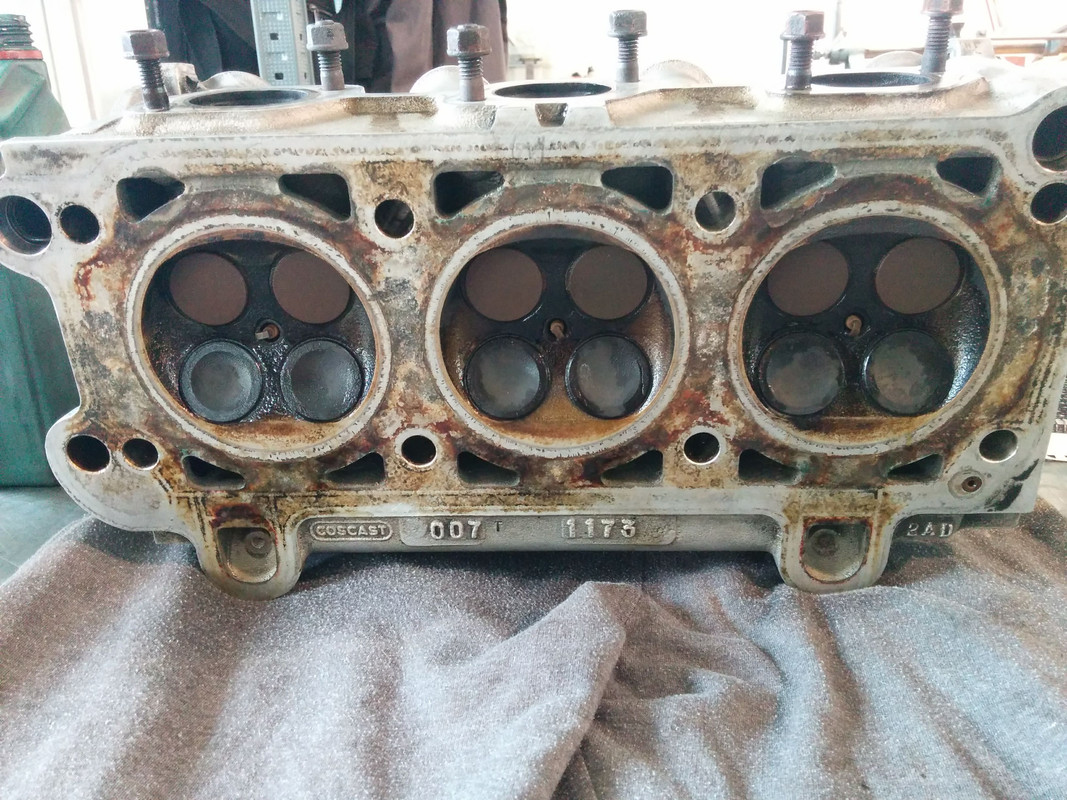
The damage in that combustion chamber is from a foreign object, marks also visible in the intake port. This will be smoothed down.
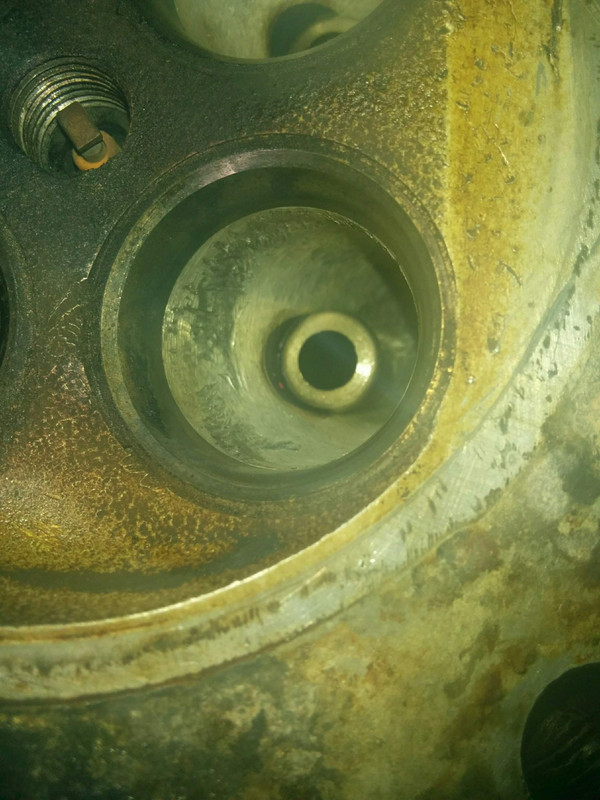
There is noticeable play in exhaust valves / guides. The guides will be replaced, and since I also have the inlet guides those will be replaced as well.
Having seen the seats now I understand how they are round shaped. They are also very nicely blended with the ports which are also properly worked surface. All in all I see why you say it's Cosworth

The heads have been sent to soda blasting, hopefully next week going over to the machining shop for resurfacing, replacing guides and recentering seats.
Re: Ghibli de Hongrie [ENG]
Publié : jeu. 28 juin 2018 22:23
par Froggie
Thank you for sharing, interesting pics.
The carbon buildup looks important indeed.
Anyway now that it's open, head resurfacing + guides' replacement + valves' seats cleaning, you will recover a fully tight head

.
Re: Ghibli de Hongrie [ENG]
Publié : ven. 6 juil. 2018 06:53
par alpa
Gaskets are not designed to last forever, like any part. But not changing the coolant of course makes things worse. Also not using the engine accelerates oxydation because this lets time to air pockets to react with coolant and metal.
Cosworth is one of best engine designers in the world. Their casting is one of the best. It's a real race engine company.
3200gt heads are even better from the flow point of view.
Such small damages can be due to a broken compressor wheel, this makes tiny pieces that are smashed and melted down in the chamber. 800-900C are enough to make them disappear.
Re: Ghibli de Hongrie [ENG]
Publié : sam. 11 août 2018 09:53
par spacecadet
Finally got back the heads.
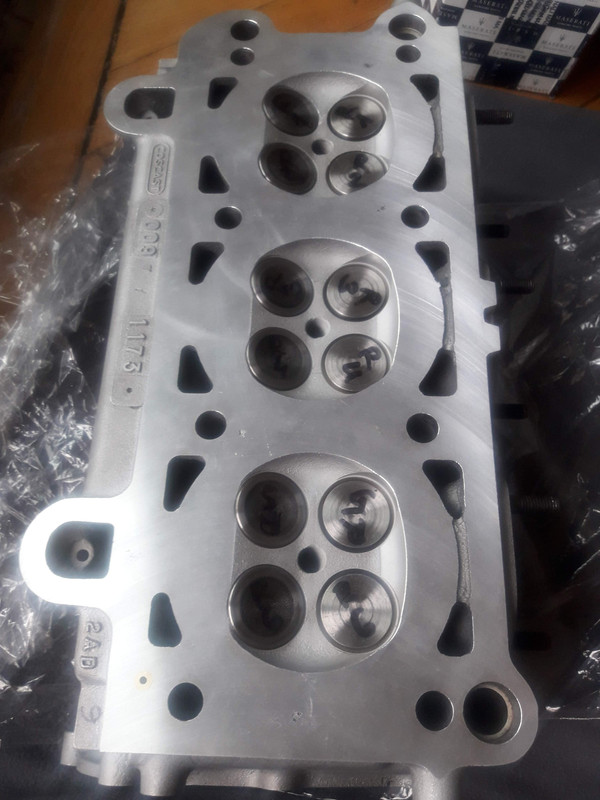
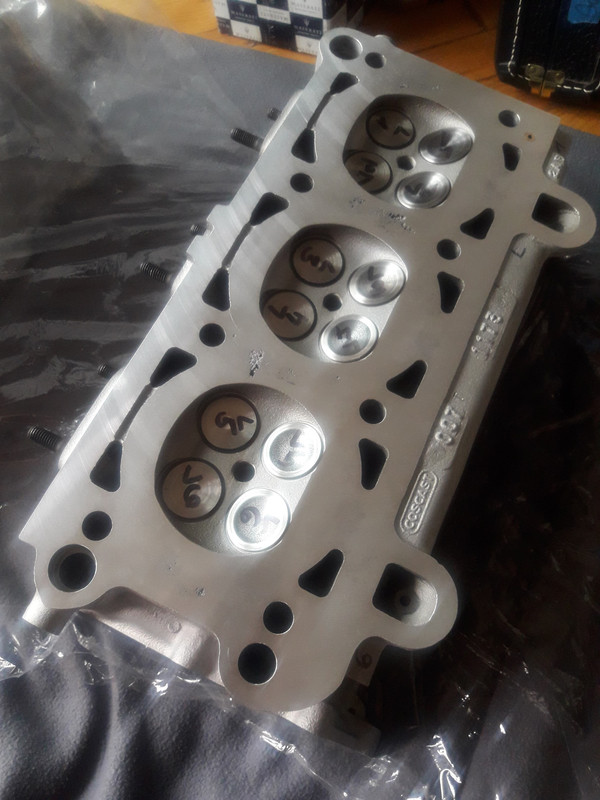
- Guides were replaced, the new guides had to be drilled out first before reaming because the valves didn't fit, their internal diameter was 6.5mm.
- Valve seats recut and recentered
- The heads pressure tested
- Finally resurfaced. This removed most of the pitting on the Right side, some still remained on the Left side. but this is where my problem starts

They had to take down 0.3mm because they were not flat, but factory limit is 0.2mm. Ok compression will increase slightly more, but the bigger problem is that I think they didn't properly level the Right head and even cut into the seating area (middle grey area) of the valve seats. Also apparent because on the Right head the casting numbers on the side are slightly cut, but not on the Left head.
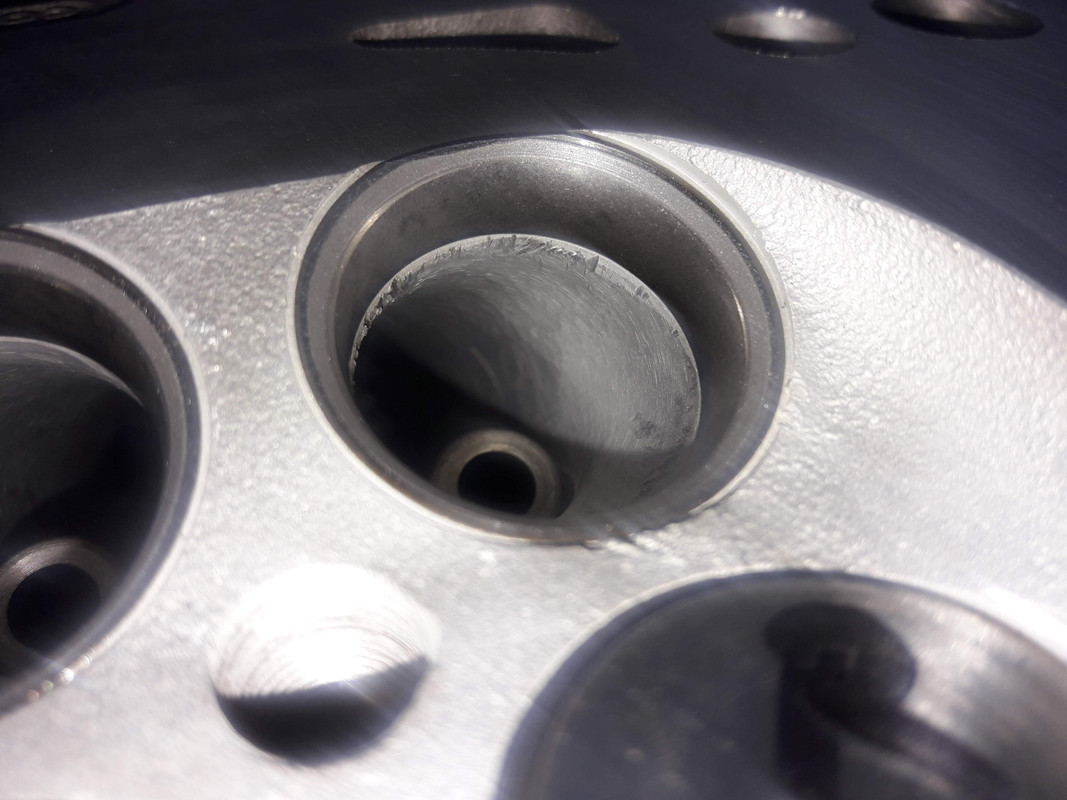
The valve job and the surfacing was done by two different machine shops, said to be best in their fields. Not sure anymore. Should I try to assemble this way or the heads and the new guides are wasted? After this I guess it's better if I also verify the valve concentricity...
Re: Ghibli de Hongrie [ENG]
Publié : sam. 11 août 2018 11:29
par alpa
I think your correct exhaust seats should be at least 1.2mm wide. If in the cut area you still have 1mm it's ok, if it's 0.5mm then I'd hesitate. Valve width is for the flow but also for valve cooling. So having such small nearow area isn't a problem I think, but it should be let's say 0.8mm wide.
Worst case just recut seats more. Exhaust valves flow better than intake, you won't impact performance.
Did they do a small second cut under the main one ? Not sure it improves anything, otherwise Cosworth would have done that.
Re: Ghibli de Hongrie [ENG]
Publié : sam. 11 août 2018 13:32
par Froggie
Pity, and strange that tolerances (0.2 mm) are that thin for resurfacing the head to maintain an acceptable area for the valve seats.
Therefore the importance of timely coolant replacements to avoid pitting of the heads surface
Also, warping a head would mean a basket case...
Seems from your pic that the seat width is about 3/5th of the nominal width, so 0.7-0.8 mm thereabout (to be checked).
And the constriction looks limited to a small area.
Maybe worth remounting as such, as alpa suggests, but difficult decision...
Re: Ghibli de Hongrie [ENG]
Publié : sam. 11 août 2018 14:16
par spacecadet
Thanks for the suggestions. I've measured and it's 0.8-0.9mm. I was also more concerned because of the cooling, but indeed it's not a very wide part compared to the whole seat. I'm a bit revealed based on your inputs, I'll probably go ahead and mount them this way.
They only cut the factory suggested 45 degrees, no second or third cut below and above.
But before mounting the heads, I'll open the bottom to check the condition of the bearings and the rings. Since the engine is already apart I decided to check everything now instead of having to open the engine later. As I know that the bottom is quite strong, except the main bearings but at least I will know how everything relates to specs.
Re: Ghibli de Hongrie [ENG]
Publié : dim. 12 août 2018 11:22
par alpa
spacecadet a écrit :
But before mounting the heads, I'll open the bottom to check the condition of the bearings and the rings. Since the engine is already apart I decided to check everything now instead of having to open the engine later. As I know that the bottom is quite strong, except the main bearings but at least I will know how everything relates to specs.
Wise decision.
Be prepared to replace main bearings. You can do replace only half of shells, the top ones are usually intact so just change the bottom ones. There is only one class for bearing so they are all the same, no problem to mix new and used if the used ones look new.
Re: Ghibli de Hongrie [ENG]
Publié : mar. 14 août 2018 21:45
par spacecadet
Good to know, thanks for the info.
Re: Ghibli de Hongrie [ENG]
Publié : sam. 8 sept. 2018 16:48
par spacecadet
I would need some help in removing the crank pulley. I have the tool, but I'm afraid that I'll break something. Of course first I've nicked the inner threads where the crank pulley bolt goes (hopefully only the first one or two) because I just threaded in the tool in itself (I don't know how Maserati thought this tool can be used in itself, or I just didn't got the other part of it when buying second hand). Then inserted a bolt which were ground down, and also applied some heat. But still nothing moves. I'm using an old belt to hold the crank while trying to thread in the tool.
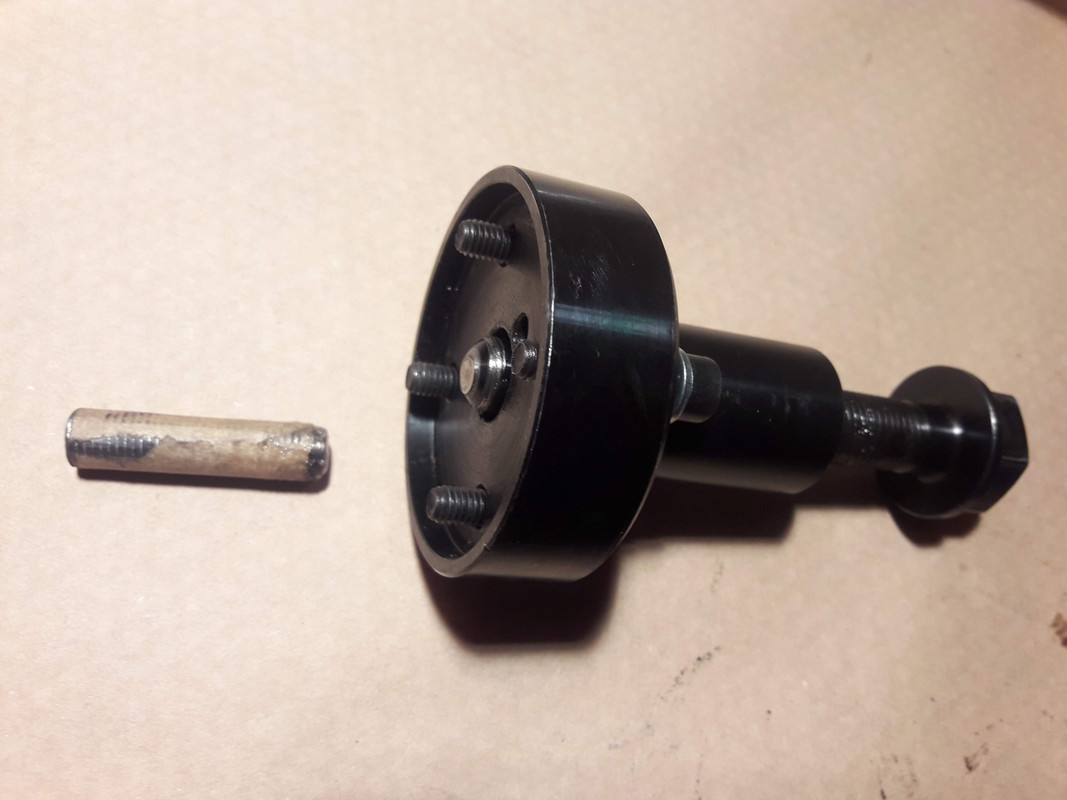
Re: Ghibli de Hongrie [ENG]
Publié : sam. 8 sept. 2018 18:45
par spacecadet
Ok it came down, more heat and properly blocking the crankshaft at the back helped.
Re: Ghibli de Hongrie [ENG]
Publié : dim. 9 sept. 2018 22:16
par spacecadet
Finished stripping down the block. The lower main bearing are definitely worn, and some of the upper ones too. Will replace these, but first measure everything.
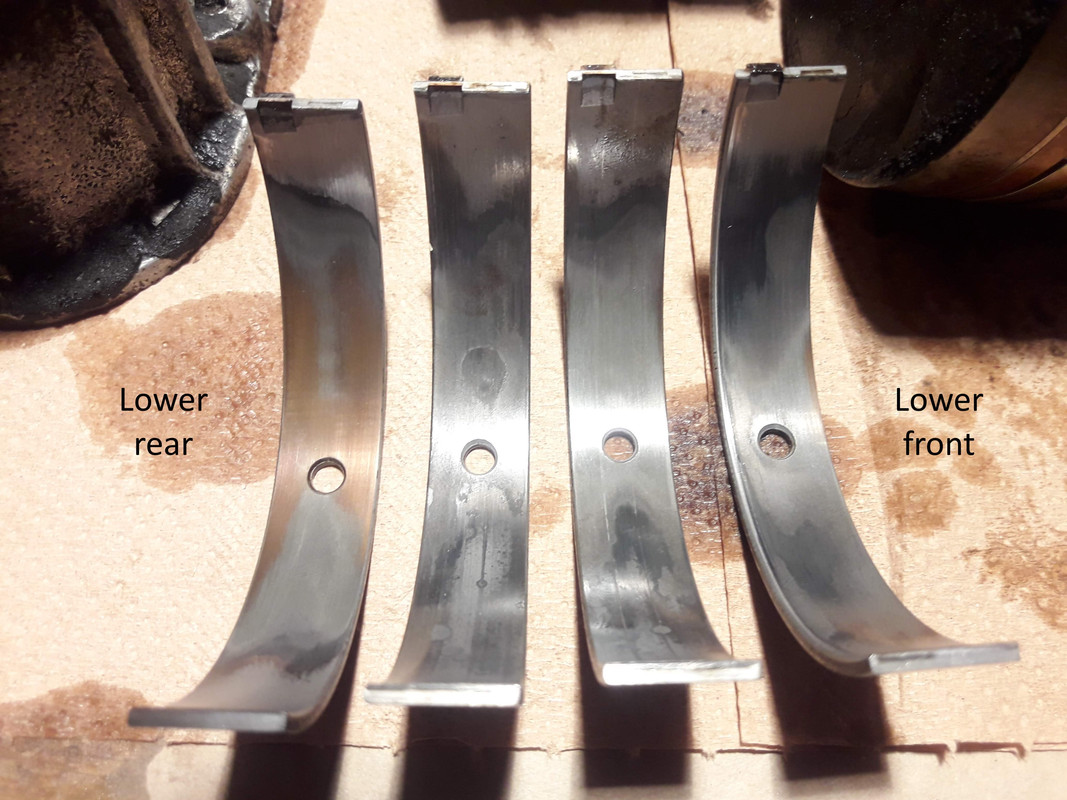
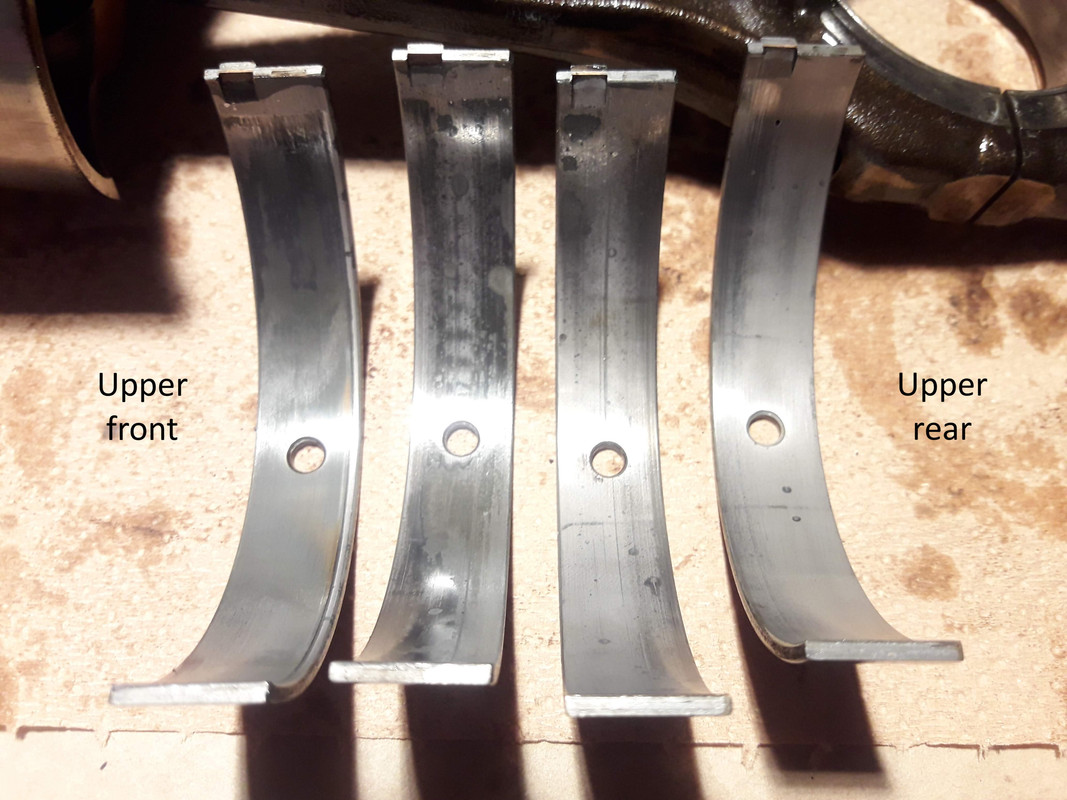
Do you know what are these marks the connecting rods? Always a character first then two numbers.
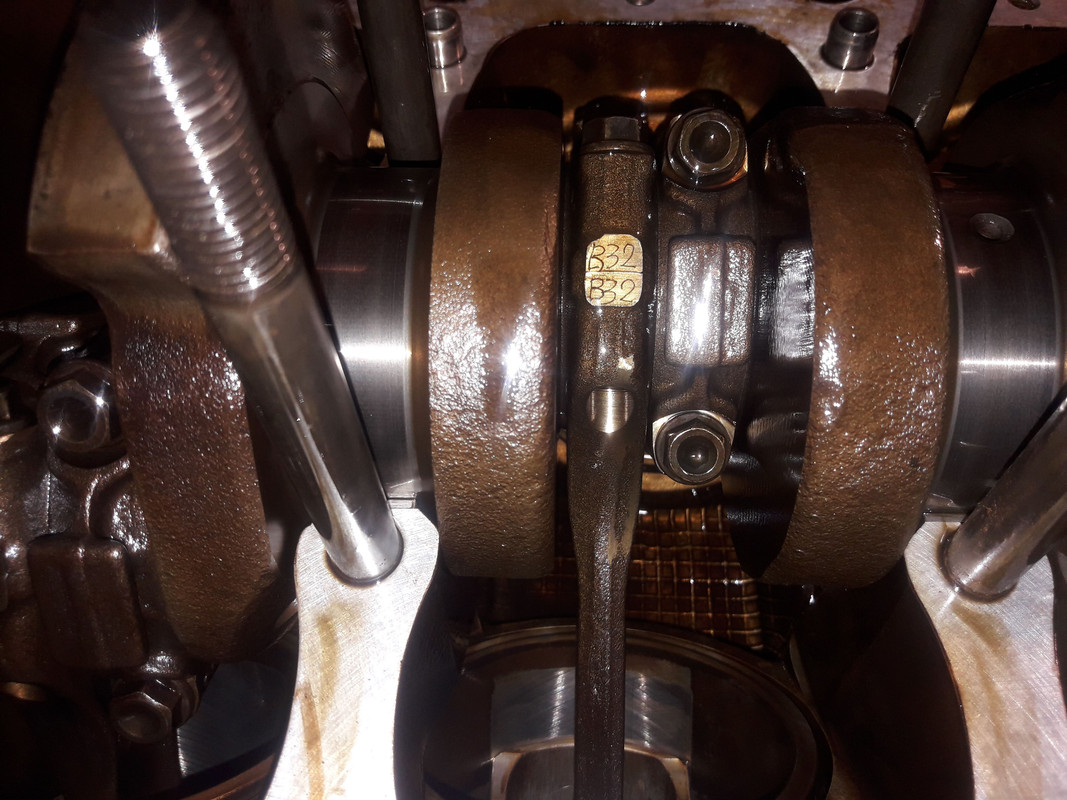
Re: Ghibli de Hongrie [ENG]
Publié : dim. 9 sept. 2018 22:24
par alpa
Never had problem to remove the pulley with a simple custom tool.
Your main bearings are in good shape compared to what I usually find.
To me marks are just lots and pairing numbers. Nevers tried to find any logic.
Weight classes are shown by color marks on the middle H section of the rods.
Don't forget to follow procedure when putting the pulley back: must be heated to something like 200C (very hot) and may be oiled, don't remember. Then goes easily and you have few seconds to adjust.
Re: Ghibli de Hongrie [ENG]
Publié : dim. 9 sept. 2018 22:45
par spacecadet
Actually the whole bottom seems to be in a quite good condition despite the nearly 150.000 kms. The honing marks are fully visible on sleeves and the machining marks too on the piston skirts (some are a bit more worn).
Yes, the rods have brown colour (should be 520 g) and the crankshaft balacing class is 1385 g. I also haven't found any logic in the marks, but at least all of them are different so I didn't have to create new marks.
The hardest was removing the pulley, and based on this I guess putting it back will be also tricky.
Re: Ghibli de Hongrie [ENG]
Publié : lun. 10 sept. 2018 00:50
par alpa
spacecadet a écrit :
The hardest was removing the pulley, and based on this I guess putting it back will be also tricky.
As I said just follow the procedure and do align well while the pulley is still hot so that you can move it (by hand). It's an interference fit, be quick and precise.
150.000km and bearings in such a good condition ... I doubt.
Re: Ghibli de Hongrie [ENG]
Publié : lun. 10 sept. 2018 21:43
par spacecadet
alpa a écrit :
As I said just follow the procedure and do align well while the pulley is still hot so that you can move it (by hand). It's an interference fit, be quick and precise.
Ok, will do

alpa a écrit :
150.000km and bearings in such a good condition ... I doubt.
There was no sign at all that this engine has been opened before.
Today we measured pistons, liners and crankshaft and everything is in limits:
- pistons have a tiny wear - 81.95 the worst
- liners well within the limit - some no wear, some 82.01 in the top or middle (82.00 in the bottom), one 82.02 at the top
- crankshaft has no measurable wear
Even the engine builder helping me was surprised about the condition.
The oiling system was also surprising, how the crankshaft gets the oil from the pump, but especially that the first main bearing doesn't get oil directly from below only from sideways?
Re: Ghibli de Hongrie [ENG]
Publié : mar. 11 sept. 2018 08:27
par alpa
I don't remember details but this engine oiling is still on the edge of best race engines of today. Oiling through the crankshaft became common quite recently.
Same for the heads' cooling circuit.
Re: Ghibli de Hongrie [ENG]
Publié : jeu. 20 sept. 2018 12:06
par spacecadet
Yes, I've read about it since then. What's special about the heads' cooling? I'm starting to understand why this engine is said to be well designed, contemporary and ahead of the others.
But I also have a new issue, maybe someone also had this here. Nearly two years ago I've bought piston rings from Carrozzeria Campana as a perparation for the rebuild but I didn't check them at that time. This week I've removed the old rings, opened the package, measured all the end gaps wanted to put on the pistons when it turned out they are 1.5/1.5/3.0 instead of 1.2/1.2/3.0 They are stating that others are using these with success, but it would be only possible if the piston grooves were remachined which I don't want to do. Or I were supplied a wrong set.
As we know the rings are not available from Maserati anymore, but did someone maybe sources custom rings from any manufacturer?








